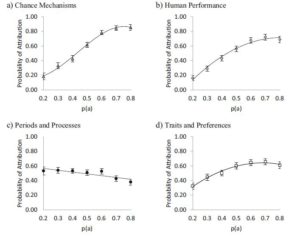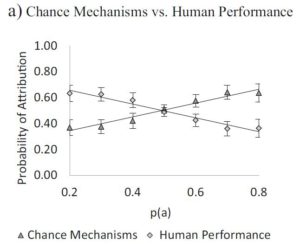Randomness and human cognition generally do not mesh well. We know that all of us, including James Bond, tend to misperceive randomness in various ways.
For example, anyone who has seen a basketball player make three shots in a row is likely to rate the chances of another success to be higher than if the player had only made one of three shots. Surely, after three successes in a row, the player’s hand must be “hot” and the fourth success must be imminent.
We’ve also all heard of the gambler who is increasingly convinced that the next number at roulette must be even, given that a growing number of spins have favored odd numbers. Indeed, when one has watched 4 odd numbers in a row, it’s difficult to escape the intuition that one’s next bet should be on even.
In actual fact, the probability of the next roulette number coming up odd or even is identical. And for the basketball player, there is no evidence of the existence of a “hot hand”: The probability of a success is not affected by how many shots a player has just made previously. Roulette sequences are entirely random and when sequences of basketball shots are analyzed statistically, they turn out to be just like roulette sequences.
Ironically, an entirely random sequence can give rise to two opposing—but equally mistaken—intuitions: The gambler’s fallacy refers to the belief that a series of identical outcomes should be followed by the opposing outcome (in roulette), whereas the hot-hand fallacy refers to the belief that a series of identical outcomes should conjure up yet-another identical outcome (in basketball). Depending on context, people resort to one or the other intuition.
Why?
A recent article in the Psychonomic Society’s journal Memory & Cognition tackled those ironic perceptions of binary sequences under uncertainty and provided a unifying explanatory framework. Researchers Fischer and Savranevski began by asking people to generate possible “explanations” for various sequences of binary events (e.g., XX000XX, where X and 0 represented the two possible outcomes) that differed in perceived “randomness”. What process might have generated XXXX0000? What about X00XX0X0?
People were quite creative, generating nearly 1,000 explanations for 36 different sequences. Intriguingly, virtually all of those 1,000 different explanations could be assigned to one of only 4 distinct categories. For example, one category referred to sequences that resulted from human performance (e.g., basketball player’s shots, tennis player getting first serve in, and so on), and the others referred to chance mechanisms (coins, roulette), traits and preferences (sleeping preferences; early risers and late sleepers), and periods and processes (rainy and sunny days).
It appears that people have fairly strong and consistent ideas about what types of processes drive the generation of sequences of binary outcomes. People agree that some sequences look like rainy and shiny days, they agree that some sequences appear to originate from a roulette wheel, and so on.
In further experiments, Fischer and Savranevski showed that we can also predict which explanation people will favor for any given sequence on the basis of its statistical structure. Fischer and Savranevski used a simple number that describes how “alternating” a sequence is, called p(a). A sequence such as XXXXXX, which has no alternations, has a value of p(a)=0. Conversely, X0X0X0 has p(a)=1, and a sequence of tosses of a (fair) coin has p(a)=.5. Fischer and Savranevski presented participants with sequences whose value of p(a) was varied systematically and asked people to identify the type of process that gave rise to each sequence, using one of the 4 categories from above.
The figure below shows the results from a study in which people had to identify each of the four categories for a number of sequences. Only two responses were possible for each sequence: Attribution to the given category or “some other process.” Each panel shows the probability of attributing a sequence to the given category as a function of p(a).

The regularities are striking: The more alternating a sequence is, the more likely it is thought to reflect a chance process. This, of course, is the signature of the gambler’s fallacy: a chance process, such as successive spins of a roulette wheel, is supposed to be alternating, and hence if it hasn’t alternated in a while one presumes that an alternation to the other outcome is increasingly imminent.
Conversely, the more alternating a sequence is, the less likely it is thought to reflect a periodic process. We expect sunshine to persist (at least occasionally) for several days, and we do not expect a rainy day to follow a sunny day, and vice versa, all the time.
One intriguing result involves the human performance panel: It resembles the data for the chance panel, which at first glance is peculiar because it runs counter to the “hot hand” notion that we often observe when people consider winning streaks in basketball and so on.
It turns out that people’s identification of a sequence as reflecting human performance is highly labile and depends on the context in which the decision is made. In two further studies, Fischer and Savranevski showed that the relationship between p(a) and the human-performance classification of a sequence is either reversed or absent when people must choose between human performance and some other specific alternative provided by the experiment. For example, when given the options “human performance” or “chance mechanism”, people systematically opt for the human-performance classification when there are few alternations in the sequence (e.g., XXX000) and they shift towards chance mechanism when there are numerous alternations, as shown in the figure below:

The figure again shows the pattern expected from the gambler’s fallacy, and it now also shows the “hot-hand” pattern for human performance. When there are few alternations, the sequence is thought to arise from a person performing a task, and by implication, when a basketball player has just made two shots, a further success is thought to be more likely than a failure.
The overall pattern of results permits two interesting conclusions: First, in confirmation and extension of prior work, people infer explanations for random sequences with remarkable consistency—some 1,000 different explanations provided by a large group of participants ultimately can be condensed into merely 4 different processes.
Second, although the statistical properties of the sequence can predict people’s explanations, those explanations are in part context-bound: when relating to the categories of chance mechanisms or periods and processes people have a fairly fixed perception, but when considering human performance or traits and preferences, perception becomes relative and people seem to consider the various alternative explanations that are presented before deciding whether a sequence was generated by a human. When the alternative is chance, then people display the “hot-hand” expectation of human performance. When the alternative is unspecified, people reveal the “gambler’s fallacy” even with human performance.
Bottom line: Actual randomness presents no barrier to people’s imagination. Humans can infer explanations for almost anything. Thus, people may conjecture that any country that builds the highest skyscraper will soon face a collapsing stock market, whereas the stock market will rise if the Super Bowl is won by the National Football Conference (rather than the American Conference). None of those explanations are any better than the belief that the next spin of the roulette wheel is bound to wake up a “sleeping number”.
